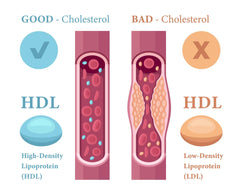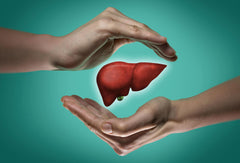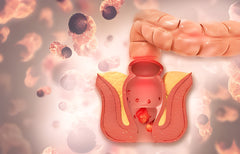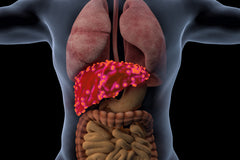Introduction
Multifactorial infections in the liver lead to severe inflammatory conditions in this organ, and it is termed Hepatitis. According to critical factors behind severe inflammation in the liver, Hepatitis is classified into several categories. Each type of Hepatitis causes severe health issues, which can be life-threatening for Hepatitis patients.
As per WHO(World Health Organization) reports, almost 354 million people are living with chronic symptoms of Hepatitis worldwide.
Symptoms & Treatments of Hepatitis depend on its type.
What Is Hepatitis?
Hepatitis is a disease that can trigger both acute(short-term) inflammatory conditions or chronic(long-term) inflammatory conditions in the liver.
The multifactorial liver infection damages internal tissues and leads to acute and chronic swelling. So, the liver functions of Hepatitis patients are interrupted or affected badly.
So, people should be conscious of different types of viral and non-viral Hepatitis conditions.
The following points are going to describe the most dangerous Hepatitis and its symptoms, causes, and treatments.
Types of Hepatitis:
Based on the factors behind severe liver infections, Hepatitis is divided into two major categories:
The following points also explain Hepatitis A,B,C,D,E in detail.
Viral Hepatitis:
- Hepatitis A:
Hepatitis A is one of the contagious liver infections which triggers inflammation and declines the standard of liver functions.
The transmission of Hepatitis - A virus into your body causes Hepatitis A. Wretched sanitary conditions and lack of hygienic sense prepare the background of Hepatitis A. Hepatitis A infection is highly contagious and breaks out as an epidemic worldwide. Hepatitis-A can become an explosive disease in any congested community as Hepatitis -A virus can travel through cyclic orders. Lack of individual sanitary arrangements triggers the chances of person-to-person transmission of Hepatitis A virus.
- Hepatitis B:
Hepatitis B is a chronic and acute liver infection that leads to inflammation in liver tissues. The prolonged inflammatory responses in liver tissues by Hepatitis B infection can cause liver Cirrhosis.
- Hepatitis C:
Hepatitis C is a severe inflammatory condition of the liver, which is triggered by the C-type hepatitis virus. The bloodborne C-Type Hepatitis virus causes mild to severe illness in the primary stage and can lead to life-threatening liver diseases such as Cirrhosis and liver cancer.
- Hepatitis D:
Hepatitis D is the most contagious and critical type of Hepatitis in humans. In most cases, the people who have already been infected by Hepatitis - B can go through the viral symptoms of Hepatitis D.
- Hepatitis E:
The entry of the E-type Hepatitis virus into your body causes liver infection, instigating inflammatory conditions. The infection by the Hepatitis E virus can be dangerous for people, who already have liver problems, or who are pregnant and immunosuppressed.
- Neonatal Hepatitis:
Neonatal Hepatitis is a critical condition of liver dysfunction that is noticed in newborn babies. Notorious viruses such as Cytomegalovirus, Rubella, and other common Hepatitis viruses -A, B & C cause Neonatal Hepatitis. Though doctors often suspect the role of notorious viruses behind Neonatal Hepatitis in babies, there can be congenital disorders.
In the cases of Neonatal Hepatitis in infants, the metabolic disorder can lead to pediatric liver failure. In most cases of acute liver failure in young children, the inherited metabolic disorders from parents play crucial roles.
Non-Viral Hepatitis:
While the severe infection in the liver is triggered by the underlying critical health issues such as metabolic syndrome, alcohol and drug effects, instead of a virus, the acute or chronic inflammation in the liver is termed Non-viral Hepatitis.
The following points describe the particular types of non-viral Hepatitis:
- Autoimmune Hepatitis
Autoimmune Hepatitis is a critical and chronic liver disease triggered by the dysfunction of your immune system.
In general, the immune system in the human body works as a defence system, which attacks germs and harmful viruses to keep your body safe from infections. But while the immune system sends antibodies to attack the healthy and functional cells of the liver, it is termed an autoimmune disease.
In these cases, your immune system produces antibodies to end the healthy liver cells. As a result, while the antibody damages the functional liver cells, it leads to severe damage in liver tissues and triggers chronic swelling in the liver.
The entire inflammatory condition in the liver is caused by an autoimmune disease, which is termed Autoimmune Hepatitis.
- Alcoholic Hepatitis
Prolonged addiction to alcohol leads to Alcoholic Hepatitis. Alcoholic Hepatitis is a severe phase of ALD (Alcoholic Liver Disease). As too much alcohol declines the ability of the liver to flush out toxins, accumulation of hepatotoxins cause severe scarring and lead to the phase of Alcoholic Cirrhosis. Alcoholic Cirrhosis damages the healthy structure of liver tissues, and liver cells start to die.
Heavy alcohol consumption triggers the rapid progress of jaundice symptoms and malaise due to the accumulation of toxins in the liver. And while liver cells are highly damaged, the acute inflammatory responses lead to Hepatitis.
Symptoms of Hepatitis:
Symptoms of Hepatitis A:
- Mild to Severe Fever
- Diarrhoea
- Abdominal Discomfort
- Loss of Regular Appetite
- Dark Tone of Urine
- Clay Coloured Stool
- Intense Itching
Symptoms of Hepatitis B:
- Chronic Fever
- Weakness & Fatigue
- Appetite Lose
- Joint Pain
- Swelling in Belly, Arms and Legs.
Symptoms of Hepatitis C:
- The following symptoms are noticed in the Hepatitis -C infected patients:
- Acute pain in the right-sided upper abdomen.
- Fluid Accumulation & Abdominal Swelling
- The pale tone of the Stools
- Fever & Fatigue
- Nausea & Vomiting
Symptoms of Hepatitis D:
- Jaundice Complications
- Frequent Upsetting of Stomach
- Long-term Fatigue
- Poor Appetite
- Changed Color of Urine and Stools
Symptoms of Hepatitis E:
- Joint Pain/Abdominal Pain
- Skin Rash/Itching
- Fatigue/Fever/Appetite Loss
- Dark Color Urine
Symptoms of Autoimmune Hepatitis:
Research claims the symptoms of autoimmune Hepatitis may differ from person to person. The significant signs of Autoimmune Hepatitis are the following:
- Fatigue
- Yellowish Eyes and Skin
- Joint swelling or pain
- Mild flu symptoms
- The larger shape of the liver & abdomen
- Spider-shaped blood vessels on the skin
- Pale Stools
- Lack of Appetite
- Fluid Accumulation in the Belly
- Rectal Bleeding
Symptoms of Neonatal Hepatitis:
Clinical researchers claim that infants, who go through Neonatal Hepatitis, can be diagnosed based on the following symptoms:
- Yellowish Skin & Eyes
- Enlarged Shape of Liver
- Elevated Level of Bilirubin
- Jaundice
Symptoms of Alcoholic Hepatitis:
- Severe pain or tenderness in the belly portion.
- Lack of Appetite
- Nausea
- Fever
- Weight Loss
- Vomiting with blood
- Yellow Skin and Eyes
Causes of Hepatitis:
Causes of Hepatitis A:
Countries where people can not afford individual sanitary infrastructure, are vulnerable to infection by the Hepatitis A Virus. In general, contaminated foods and water quickly spread the Hepatitis A virus. The unhygienic, poor sanitary and water supply infrastructures are highly responsible for breaking out the Hepatitis A virus among children before they reach the age of 10 years.
In the cases of adults involved in oral-anal sex, they can be infected easily by the Hepatitis A virus.
Moreover, a lack of a water purification system, sanitary practices, and contaminated food can transmit Hepatitis A Virus. If you stay closer to the Hepatitis A infected person in your family, use the same toilet, or engage in sexual intercourse with them, you will also be infected. If you consume uncooked shellfish, which is grown in the polluted sewage water
Poor sense of sanitation, lack of awareness about safe water, and physical intimacy with infected friends in schools & family members at home often increase the risk factors of Hepatitis A in childhood.
Causes of Hepatitis B:
As Type -B Hepatitis virus is highly contagious, it is transmitted through body fluids and blood. So, if you become involved in sexual intercourse with Hepatitis -B infected patients, the entry of notorious virus causes Hepatitis -B infection in your liver. Besides, during the delivery of infants, the Hepatitis - B virus is easily transmitted from mothers to babies. If you are injected with used syringes, it also becomes a risk factor for Hepatitis B as the body fluid of Hepatitis -B infected people spreads the virus.
Hepatitis B virus can not be transmitted via water or food like the cases of Hepatitis -A infection.
Causes of Hepatitis C & D:
People who come into contact with infected blood by Hepatitis -C virus can be the victim of Hepatitis C & D. If healthcare professionals use an infected needle to inject drugs, it causes Hepatitis C. The unsterilized equipment used for tattoo or body piercing can spread Hepatitis C & D. If a mother is infected by Hepatitis C virus, then newborn babies can be easily infected by Hepatitis C virus.
Causes of Hepatitis E:
Both animals and humans carry the E -type Hepatitis Virus. So, in different cases of Hepatitis E disease, people who consume contaminated water, undercooked deer & pork meat are infected by Hepatitis -E virus.
Causes of Autoimmune Hepatitis:
According to researchers, critical mechanisms of the immune system are responsible for Autoimmune Hepatitis. Autoimmune Hepatitis is common in both males & females. The following points explain how different autoimmune conditions lead to autoimmune Hepatitis.
- Type 1 Diabetes:
Type 1 diabetes is an autoimmune disease in which the body's immune system destroys the beta cells of the pancreas and interrupts the insulin production mechanism. So, patients with Type -1 diabetes often experience fluctuating sugar levels in the bloodstream. And the entire condition affects metabolic control, as well as hepatic glycogen storage in the liver.
The purpose of glycogen storage is to supply energy to the body's muscles through enzyme glucose metabolism.
Type-1 diabetes is an autoimmune condition that triggers the decline of insulin production and disrupts glycogen metabolism. As a result, the cognitive impairment of glycogen metabolism leads to excess glycogen accumulation in the liver. Naturally, Hepatocytes are overloaded with glycogen.
Hepatocytes act as the parenchymal liver cells, which regulate several cellular functions such as overall metabolism(Lipid, Protein and Carbohydrate), detoxification mechanisms and activation of immune cells. So, while Hepatocytes- the Parenchymal Liver Tissues Are overloaded with glycogen, it fails to maintain regular liver homeostasis. And while liver homeostasis is interrupted, it leads to liver inflammation in different ways.
Thus, Type 1 diabetes is responsible for Autoimmune Hepatitis.
- Thyroiditis:
Both overactive and underactive thyroid functions are interlinked with liver functions. The low production of Thyroxine hormone in your thyroid gland leads to Hypothyroidism(underactive thyroid).
Thyroid hormones play essential roles in executing Lipid metabolism through the consistent coordination between adipose tissues and enzymes.
In Hypothyroidism, underactive thyroid triggers congenital disorders, which affect the mechanism of lipid synthesis and impair the distribution and degradation process of lipids in the liver. As a result, the liver fails to remove LDL cholesterol efficiently. Therefore, in Hypothyroidism, cholesterol absorption in the gut is heightened, and Triglyceride and LDL plasma levels become high in the liver.
Eventually, in Hypothyroidism, excess Lipid profile boosts the oxidative stress in the liver. As a result, Hypothyroidism triggers the abnormal inflammatory response in your liver.
So, as an autoimmune disease, Hypothyroidism causes chronic inflammatory conditions in the liver, termed autoimmune Hepatitis.
- Celiac Disease:
Celiac disease is one type of congenital disorder that affects the digestion ability of people while they consume Gluten-rich foods such as Barley, Rye and Wheat. People with Celiac disease often experience a destructive autoimmune response in the body, which attacks the filter-shaped Villus lineup in the small intestine. Villus is a significant part of the digestive system, which boosts nutrient absorption in the body. While Celiac abnormality triggers the autoimmune attack against Villi, it blocks nutrient absorption in your body.
Celiac disease is itself an autoimmune disease, which is interconnected with autoimmune liver inflammation.
People with Celiac disease often face indigestion issues after consuming gluten-rich foods as the plant-based protein Gluten triggers the overactive immune response in the body and attacks the thread-like membrane in the intestine. In this condition, while Celiac autoimmune disorder leads to gluten allergy or gluten intolerance, the liver produces several enzymes such as ALT (Alanine Aminotransferase), AST(Aspartate Aminotransferase), GGT(Gamma-Glutamyl Transferase), ALP (Alkaline Phosphatase) in high amount.
Thus, celiac autoimmune disorder triggers the elevation of liver enzymes, which heightens the concentration of CRP (C-reactive protein) in the liver. It means the liver is affected by chronic autoimmune hepatic inflammation.
Causes of Neonatal Hepatitis:
HBV Transmission:
Neonatal Hepatitis in young babies can be the consequence of the vertical transmission of the Hepatitis - B virus from mother to child during the delivery of newborns.
If the pregnant woman carries Hepatitis - B virus throughout her pregnancy, then the transmission of this virus is standard during childbirth. In recent times, HBV transmission into newborns has become an epidemic across the world.
Medical Science claims HBV is transmitted from infected mothers to newborns via three possible routes.
- Transplacental Transmission In Utero:
In the cases of preterm labour and premature delivery, spontaneous contractions of uterine muscles lead to transplacental leakage, allowing the swapping of maternal and fetal blood. If the mother of a newborn is a carrier of HBV, then HBeAg-positive maternal leakage transmits HBV into newborns.
Thus, Transplacental Transmission In Utero causes Neonatal Hepatitis in infants.
- Natal Transmission During Delivery:
During delivery, spontaneous maternal secretion prepares the mother's cervix for labour. In these moments, the mucus plug is exposed and leads to vaginal discharge in the cervical canal to soften the cervix and vaginal wall.
In the cases of HBV carrier pregnant women during delivery, maternal discharge can quickly spread the HBV to the newborns. Thus, the Natal transmission of HBV often causes Neonatal Hepatitis in young babies.
- Postnatal Transmission During Feeding Breast Milk or Care:
If the mothers of newborn babies are infected by Hepatitis -B virus during their whole pregnancy journey, then the DNA of HBV is already present in their breast milk. Now, while Hepatitis-B infected mothers of newborns start feeding their babies, HBV is easily transmitted to their infants.
Thus, the breast milk of HBV-infected mothers increases the risk factors for Neonatal Hepatitis.
Cholestasis:
Cholestasis is a critical health issue that is noticed among newborn babies within two weeks of delivery. Cholestasis in infants leads to Neonatal Hepatitis. The crucial factor behind Cholestasis is a deficiency in bile formation in infants.
While the liver breaks down fat content, it produces a digestive fluid called - bile. The following factors are responsible for the reduced or declined flow of bile, and the condition is termed Cholestasis. Undoubtedly, biochemical obstructions in bile flow heighten the risk factors of Neonatal Hepatitis.
- Biliary Atresia:
Biliary Atresia is one critical health issue in infants, when the biochemical mechanism of intrahepatic bile production, transport of bile via transmembrane & bile flow declined due to congenital disorders.
In the critical condition of Biliary Atresia, bile ducts fail to carry bilirubin & bile acids from the liver to the gallbladder. As a result, elevated bilirubin levels lead to Hyperbilirubinemia, which is very common in infants in their first couple of months.
Thus, as the significant factor behind Cholestasis, Biliary Atresia causes dark urination, pale stools, and swollen stomach in cases of jaundice in infants.
Causes of Non-Viral Hepatitis:
MLD (Metabolic Liver Disease) is the primary culprit behind Hepatitis.
In general perspectives, Hepatitis-driven inflammation is associated with a group of disorders such as - in-depth metabolic alterations, mitochondrial function alterations, decline of synthesis, transport and oxidation of fatty acid, alterations of protein metabolism and heightened glycolysis.
The obesity-driven MLD (Metabolic Liver Disease) instigates multifactorial metabolic complications during pregnancy. And these metabolic complications create obstacles in the pathway of fatty acid trafficking from adipose tissues to liver cells.
Metabolic complications also pose mitochondrial dysfunctions, which hinder Carbohydrate Metabolism. As a result, excess amounts of carbohydrates are turned into fatty acids. But, due to a lack of fatty acid trafficking ability, fatty acids are esterified into triglycerides. Thus, metabolic disorder correlates with mitochondrial dysfunctions, carbohydrate metabolism and fatty acid distribution. And the entire biochemical mechanism leads to hepatic Lipogenesis, which causes hepatic inflammation.
So, during pregnancy, obese women are prone to acute hepatic inflammation as they experience Metabolic Liver Disease. And metabolic liver disease-driven hepatic inflammation plays essential roles in non-viral Hepatitis.
Too much alcohol consumption often heightens the risk factors of Hepatitis. In a general perspective, heavy drinking instigates inflammatory responses in the liver. Primarily, the entry of excess alcohol into your system affects the gut microbiome. As a result, the balance between good & bad bacteria has declined.
Thus, core dysfunction in intestinal microbiota triggers intestinal permeability.
Intestinal permeability exposes the liver axis to pathogen-associated molecular infections and damage-associated molecular infections. So, due to excessive alcohol consumption, intestinal microbiota dysfunction causes sterile inflammatory conditions in the liver, which leads to Hepatitis.
Moreover, long-term heavy drinking of alcohol executes the layers of ethanol metabolism in the liver. In this phase, the byproducts of ethanol metabolism inhibit the oxidation of fatty acids. The entire effects of ethanol metabolism trigger hepatic Lipogenesis, leading to liver inflammatory responses. So, there is no doubt that alcohol consumption is responsible for Hepatitis.
Alcohol affects the liver step by step, which gradually leads to Hepatitis. In the initial phase, alcohol substance in the liver causes Steatosis, then the next phase is Fibrosis, and the final phase is CirrhosisCirrhosis. And the severity of inflammatory responses increases step by step in the cases of Alcoholic Hepatitis.
Diagnosis of Hepatitis:
- Diagnosis of Hepatitis A:
Like other viral acute types of Hepatitis, Hepatitis -A can not be detected by clinical methods. The measurement of antibodies(HAV-specific Immunoglobulin IgM) in blood defines the detection method of the Hepatitis A virus. Besides, additional laboratory tests such as - RT-PCR (Reverse Transcriptase Polymerase Chain Reaction) are required to detect Hepatitis A.
- Diagnosis of Hepatitis B:
Serological screening in diagnostic centers can identify Hepatitis -B infection. The serum or plasma is collected from the patients to execute the Serological test, which confirms the HBV infection.
Besides, Hepatitis B Panel Tests or Surface Antigen test include triple screening types to detect Hepatitis B virus.
- HBsAg test detects surface antigen against the Hepatitis B virus in the blood.
- HBsAB test hints at surface antibodies against the Hepatitis B virus.
- HBcAB test detects the core antibody against the Hepatitis B virus. This test can identify past or current infections by the Hepatitis B virus.
In some cases USG and LFT can help to detect the symptoms of Hepatitis B infection.
EIAs (Enzyme Immunoassays) are a proven screening method to detect the antibodies against Hepatitis - C virus in the human serum. The human body itself produces antibodies to fight against any infection. So, the positive report of the EIAs test directly confirms Hepatitis -C infection.
Besides, PCR (Polymerase Chain Reaction) screening measures the viral load and recognizes the type - Hepatitis C virus.
Moreover, doctors recommend several tests to monitor the severity of liver damage. The following tests identify Hepatitis C Virus driven liver damage:
- Test of Albumin Level
- Liver Function Test
- Prothrombin Time
- Liver Biopsy
- Diagnosis of Hepatitis D:
The collected serum or plasma is tested to detect HDV RNA. If serum and plasma screening recognizes HDV antibodies with the RIA (radioimmunoassay) and EIA immunoassay kits, it confirms Hepatitis D infection.
- Diagnosis of Hepatitis E:
Hepatitis E infection can be diagnosed based on the detection of specific antibodies - Immunoglobulin M. The following screening process to detect anti-HEV IgG is effective in diagnosing Hepatitis E disease:
- EIA
- ELISA
- Rapid Immunochromatography
- HEV RNA Test With Serum
- Reverse Transcriptase PCR With Stools
Treatment of Hepatitis:
- Treatment of Chronic Hepatitis B
To heal the Hepatitis - B-related infection in the liver, doctors recommend effective antiviral medicines such as - Entecavir, Tenofovir, Telbivudine, Viread, Lamivudine, and Adefovir. All the drugs are oral antiviral medicines, which improve the inflammatory conditions of the liver.
Moreover, Interferon Injections work effectively to heal Hepatitis B infection.
Timely birth does help to control the spreading of hepatitis B in newborn babies.
- Treatment of Hepatitis A
Instead of any specific drugs, the body heals itself from the infection by the Hepatitis A virus, clearing it from the body. In the cases of Hepatitis - A, the liver takes almost six months to heal the internal damage. In the cases of Hepatitis A, doctors recommend milk or fruit juice along with water to prevent dehydration when patients face vomiting and diarrhoea. In the cases of Hepatitis A, Nausea often causes discomfort in consuming foods. So, Hepatitis A patients must take snacks several times if they can not eat full meals. Moreover, Hepatitis A patients often feel sick and have low energy, so they must consume high-calorie foods.
- Treatment of Hepatitis C
DAA tablets work the best to treat Hepatitis C conditions. Doctors also recommend DAA tablets as the safest drug to heal infections caused by the Hepatitis C virus. If you intake DAA medication timely, you can prevent the risk factors of liver damage and the chances of contagious infection. Moreover, several antiviral medicines such as- Elbasvir Grazoprevir, Glecaprevir-Pibrentasvir, Ledipasvir-Sofosbuvir, and Ribavirin can treat HCV conditions effectively.
- Treatment of Hepatitis D
Pegylated Interferon Alpha is the effective treatment of Hepatitis D. However, patients with Cirrhosis symptoms, psychiatric disorders and autoimmune diseases are not eligible for this treatment.
- Treatment of Hepatitis E
Any specific antiviral therapy does not work to heal the Hepatitis E condition. So, doctors always recommend supportive therapy such as proper rest, intake of fluids, and sufficient nutrition, as the liver can heal the internal infection by hepatitis E virus within 2 to 6 weeks.
Above all, though you are following antiviral medications or supportive therapy to heal the liver infection caused by Hepatitis A, B, C, D, and E viruses, you always need to avoid alcohol to recover from this disease. Because, in Hepatitis, the severe inflammation and damages of liver tissues turn the liver unable to digest alcohol anyway. Besides, in alcoholic hepatitis conditions, you have to avoid alcohol strictly.
FAQs About Hepatitis:
- What Is The Most Dangerous Hepatitis?
Hepatitis B is highly dangerous as this disease is considered a silent killer of the liver. The chronic symptoms of Hepatitis B cause long-term health issues such as liver damage, liver failure and liver cancer. Most of the time, when the Hepatitis B virus is transmitted into your body, initially, you do not face any significant health issues. Even a general blood test shows the routine measurement of liver enzymes. But, over time, the symptoms of Hepatitis B, such as abdominal pain and joint pain, are noticed in patients. Then doctors recommend Hepatitis B Panel Test for accurately detecting the Hepatitis B virus. But, it’s too late to reverse the healthy liver condition with treatment.
Moreover, Hepatitis B is a hepatotropic DNA virus that belongs to the Hepadnaviridae family. As the hepatotropic DNA virus is highly contagious, without timely vaccination and proper medications in time, chronic Hepatitis B can not be cured.
- How Hepatitis Is Spread and Transmitted?
Unfiltered water and poor infrastructure of sanitization in commercial places can quickly spread the Hepatitis A virus.
The highly notorious Hepatitis -B virus can be transmitted via reused & infected needles, sexual intercourse and body fluids such as menstrual, vaginal and seminal fluids & saliva.
Unsterilized medical equipment in hospitals and diagnostic centers and unsterilized piercing tools at salons and tattoo shops can quickly spread the Hepatitis C virus.
Hepatitis D can be easily transmitted via broken skin, such as injection & tattooing with used needles. Besides, the blood & body fluids of an infected person can spread the Hepatitis D virus.
Undercooked meat & contaminated drinking water spread the Hepatitis E virus.
Conclusion
All the information describes the types of Hepatitis, causes of Hepatitis, symptoms of Hepatitis, Diagnosis & treatment of Hepatitis. So, after glancing at the points, you must be aware of the risk factors of Hepatitis.











